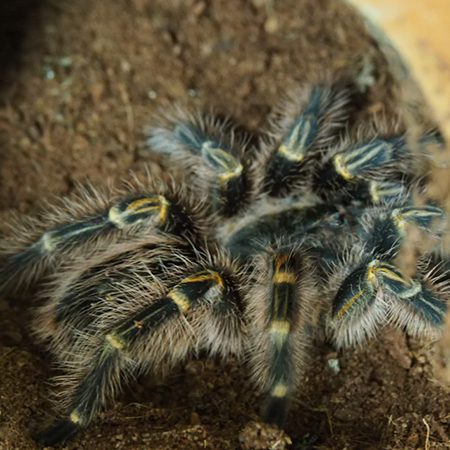Pink Toe Tarantula
Avicularia avicularia
Pink toe tarantulas are very good pets due to their docile nature. They are very adaptable to different environments, making them ideal animals to keep in captivity. These spiders grow slowly, taking 4 years or more to reach maturity. Females can live for ten or more years beyond that, but males don’t live for much more than a year. The name pink toed very obviously comes from the pink tinted hairs covering the ends of their legs. Like other tarantulas, they will shed their body hairs when stressed. The hairs will then stick into whatever may be attacking them and can do damage varying from irritation to a severe reaction. Their bodies otherwise are dark brown, including their pedipalps (what people call the fangs on tarantulas). These are not true teeth, however, though they are used to inject venom into their prey. All spiders have these, they are just more pronounced on big spiders like tarantulas.
Though tarantulas are feared by many people, they are not aggressive and are generally more afraid of people than you are of them. Tarantulas are soft-bodied despite their exoskeleton and do not do well when dropped. They are also very vulnerable when they have to molt, as they have to shed their protective exoskeleton and may have to wait several hours before they grow a new one. They are incredibly sensitive in that time period and are vulnerable to predation. In captivity, it is very important to not disturb them until they are ready or they can easily be killed.

These Tarantulas are native to Argentina and Paraguay.
HABITAT -The rainforests of southern Central America and northern South America.
DIET -They mainly eat insects and occasionally small lizards and mammals.
FUN FACT -This is the first tarantula species identified by Linnaeus in 1795.
SOCIAL BEHAVIOR -They are solitary animals but some of the most docile spiders to humans.
ACTIVITY -Being nocturnal, they are active only at night.
PREDATORS -Large mammals, reptiles, or other tarantulas are known to eat them.
SIZE -They can grow to have a leg span of 3.5-5 inches.
RELATIVES -They are related to twelve other pink toed tarantulas, differentiated by where they’re found.
CONSERVATION -They are not evaluated by the IUCN.
Cub Creek Animal Care Information
Housing - Our tarantula is housed in a tall 5-gallon terrarium that is designed to simulate her natural environment. The bottom is covered in sphagnum moss and she has sticks and artificial plants to climb, hide under, and build webs.
Diet - We feed our tarantula crickets. Tarantulas do not need to eat often, so we only give her more when she has run out. On average, we give about 5 crickets a week.
Enrichment - Invertebrates get much of their enrichment through exploration of their enclosure, rather than the toys or puzzle boxes that we provide for much of our other animals. Our campers give her additional stimulation by handling her throughout the summer.


